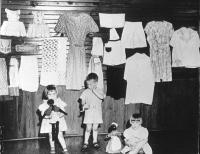50th Anniversary Celebration
| Promotion in the early days…NC State Cotton Extension NCDA Leadership Strong Production/Marketing Milestones NC Cotton Promotion Leadership |
 50th year president David Grant, Berrye Worsham, Cotton Inc. CEO, and first president Wiley Long, Jr.  Old timers JB Barnhill and Bill Dickerson reminisce at 50th year anniversary celebration. Old timers JB Barnhill and Bill Dickerson reminisce at 50th year anniversary celebration. |
NC COTTON PROMOTION IN THE EARLY DAYS…
in a 1958 report from Wiley J. Long, Jr., first president of the association
- In 1957, the NC Legislature authorized referendum was approved 9 to 1 in favor by growers-it called for a 10- cent per bale contribution each year to support the North Carolina Cotton Promotion Association. It is the officially recognized cotton farmer organization in North Carolina under the authority of the enabling act of the General Assembly, which calls for self-help through voluntary assessments.
 Fritz H. Heidelberg, former southeast area rep for National Cotton Council, was named the group’s first executive officer. His job was to guide the association into development and execution of a comprehensive program for the good of cotton production and processing in North Carolina.
Fritz H. Heidelberg, former southeast area rep for National Cotton Council, was named the group’s first executive officer. His job was to guide the association into development and execution of a comprehensive program for the good of cotton production and processing in North Carolina.- Often, Heidelberg was heard to say, “We’re a cotton organization dedicated to improving the welfare of cotton farmers in North Carolina. Farmer delegates selected by the NC State Grange, NC Farm Bureau and NC Cotton Growers Cooperative make up the group’s Board of Directors. A minority of board members representing other segments of the cotton industry assist the farmer directors in developing a well rounded program of progress for cotton.”
- The 50s was a time of declining cotton acreage, public apathy toward cotton’s importance and unfavorable legislative restrictions. Cotton leaders in the state saw that cotton’s situation nationally and internationally was improving, while at the same time, by legislative decree and general indifference, cotton was withering on the vine in North Carolina. They saw the pressing need to awaken responsible forces in the state to the unbelievably fantastic story of dwindling cotton production and cotton industries in the face of the facts that in North Carolina cotton is an indigenous crop.
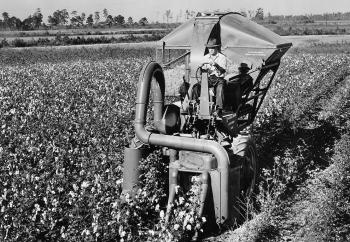
- In North Carolina, our land is suited to cotton production. There are growers who want to grow it. The climate is favorable. A well equipped ginning plant is established. A seed crushing industry wants seed to process. A marketing system is at hand. A warehousing plant stands ready and adequate. And, a textile industry using 2 million bales yearly is in operation.
- The real cotton farmers and leaders of industries allied to it, know that there is a place for cotton in NC. They know it is needed in the pattern of agriculture and agribusiness. They also know they cannot hope for cotton farming, or its related industries, to survive without an intense program of education, legislative defense, promotion and public relations. Fresh interest was also needed to advance cotton research and production developments in the state.
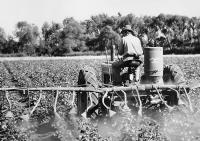 In the brochure, entitled “New Look at Cotton-North Carolina’s Major Industry,” this statement was prominent on the minds of Association leaders at that time: “Take the present know-how and the present allotment of about 500,000 acres. Then increase the yields from this acreage only 60 percent-which is less than the percentage increase for any other major crop grown in North Carolina. The increased income would be $80 per acre or $40,000,000 to the farmers besides increased income and benefits to the other segments of the cotton industry.”
In the brochure, entitled “New Look at Cotton-North Carolina’s Major Industry,” this statement was prominent on the minds of Association leaders at that time: “Take the present know-how and the present allotment of about 500,000 acres. Then increase the yields from this acreage only 60 percent-which is less than the percentage increase for any other major crop grown in North Carolina. The increased income would be $80 per acre or $40,000,000 to the farmers besides increased income and benefits to the other segments of the cotton industry.”
Wiley J. Long, Jr. was among the fifth generation of his family born and raised on Longview Farm near Roanoke Rapids, NC. The Northampton County farm, which raised cotton dating back to its origination in 1827, was later operated as Long Brothers Farms (with Wiley’s brother William).
Wiley, who came back to farm with his dad following WWII service and graduation from UNC-Chapel Hill in 1947, remembers ’52 as the best crop the farm had ever made-more than a bale an acre. He remembers the boll weevil, too, which while it never put the Long’s out of growing cotton, reduced yields to less than a half a bale per acre. Wiley also claims to have been the first farmer to mechanically pick cotton and then gin it in North Carolina.
After being named as the first president and lobbyist of the North Carolina Cotton Promotion, Wiley remembers staying on as a director for another 25 years. He also went on to serve as a director of the National Cotton Council. Wiley and Fritz Heidleberg were involved in the formation of the Southern Cotton Growers/Southeastern Cotton Ginners Association. He was also instrumental in getting Cotton Incorporated to locate its research facilities in Raleigh, nearby the many cotton mills located in the Carolinas.
NC STATE COTTON EXTENSION VALUABLE PARTNER TO PROMOTING COTTON IN NC
Even though cotton was booming by 1910, it wasn’t until 1927 that a crop science specialist was assigned to work exclusively with cotton. In 1927, J.A. “Bud” Shanklin was employed to promote “one variety communities”-a program to assist the marketing of cotton with uniform fiber length and quality. Shanklin’s work, much of which was during the period when cotton acreage was declining, resulted in improved quality of staple of cotton produced.
In his last few years of service in the NC State Crop Science Department, Shanklin was asked by Extension Director D.S. Weaver, to assist cotton producers in the formation of the NC Cotton Promotion Committee. His signature is also found on the 1958 incorporation papers filed with the NC Secretary of State to form the North Carolina Cotton Promotion Association. Shanklin retired in 1960.
Glen Toomey served as cotton specialist from 1960 to 1978. He worked closely with the NC Cotton Promotion Assn. in soliciting support for the cotton program. He was also heavily involved in the Cotton High I-Q program, which was designed to develop quality cotton. Toomey also developed the “All Practice” Cotton Program to promote improved economical cotton production. After his retirement, Glenn continued to serve as NC Cotton Promotion Assn. recording secretary well into the 90s.
Dr. Alan C. York served as cotton specialist from 1978 to 1983. He carried out a well-recognized educational program and strong on-farm test program with cotton. When York transferred to become a weed science specialist in 1983, Dr. David Guthrie was appointed Cotton Specialist. Our current NC State cotton specialist, Dr. Keith Edmisten, came aboard in 1992.
NCDA PLAYED KEY ROLES IN PROMOTING COTTON OVER THE YEARS
 Back early in Jim Graham’s career as NCDA Commissioner of Agriculture, North Carolina’s cotton growers came to him for help in fighting the boll weevil. It was just the start of a fruitful relation the Commissioner built with the state’s cotton industry.
Back early in Jim Graham’s career as NCDA Commissioner of Agriculture, North Carolina’s cotton growers came to him for help in fighting the boll weevil. It was just the start of a fruitful relation the Commissioner built with the state’s cotton industry.
Using the staff and resources of his department, Graham first led the fight by getting the authority of the Legislature to hold a referendum vote which would require mandatory  grower participation in fighting the pest. When that measure passed, in 1978 the North Carolina Boll Weevil Eradication Foundation assessed growers in the 15,000 acre target area $50 an acre to run the program.
grower participation in fighting the pest. When that measure passed, in 1978 the North Carolina Boll Weevil Eradication Foundation assessed growers in the 15,000 acre target area $50 an acre to run the program.
Just a few short years (but a long time for battling cotton growers) later, the boll weevil was eradicated in North Carolina. While the pest was “licked,” Graham’s legacy continues in cotton fields around the state with the ever-familiar green boll weevil traps that still exist today.
In more recent years, Graham’s department led the way in other efforts to promote Cotton in the Tar Heel state. For a long time, NCDA’s marketing group has been active in promoting cotton to consumers. They’ve developed endless TV and radio spots and cooperative promotions with retailers promoting cotton to NC’s growing buying public. Their continuing message: “Goodness Grows in North Carolina!”
LEADERSHIP STRONG IN COTTON PROMOTION!
Originated as the North Carolina Cotton Improvement Committee in the early 50’s under the leadership of D.S. Weaver, NC State College of Agriculture Dean, who appointed J.A. Shanklin the responsibility of redeveloping cotton production in North Carolina. In 1958, the organization officially was registered with the Secretary of State as the North Carolina Cotton Promotion Association, Inc.
North Carolina Cotton Promotion Association, Inc Presidents
Over the past 50 years several North Carolinian’s have been dedicated leaders of cotton causes at the national level. They include:
 Francis J. Beatty, a Charlotte warehouseman, who served as NCC President and Chairman in 1956 and 1957, was instrumental in forming the North Carolina affiliate.
Francis J. Beatty, a Charlotte warehouseman, who served as NCC President and Chairman in 1956 and 1957, was instrumental in forming the North Carolina affiliate.
- David L. Burns of Lumber Bridge served as Cotton Board president in 1999 and 2000 and is serving as chairman in 2001.
- W.L. “Billy” Carter of Scotland Neck has served as chairman of the
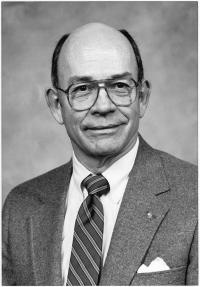 American Cotton Products (ACP) of NCC and the last three years as Chairman of the ACP Policy Committee.
American Cotton Products (ACP) of NCC and the last three years as Chairman of the ACP Policy Committee.
- Marshall W. Grant of Garysburg has served as Chairman of the Boll-Weevil Eradication Program since its inception in 1978.
- W.D. “Bill” Lawson. a Gastonia cotton merchant, served as NCC President and Chairman in 1976 and 1977.
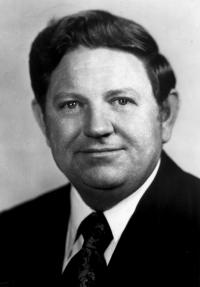 C. Hoke Leggett, a Hobgood cotton producer, served as chairman of the American Cotton Producers (ACP) in 1975 through 1978 and then served as NCC President and Chairman in 1979 and 1980.
C. Hoke Leggett, a Hobgood cotton producer, served as chairman of the American Cotton Producers (ACP) in 1975 through 1978 and then served as NCC President and Chairman in 1979 and 1980.
COTTON PRODUCTION/MARKETING MILESTONES OVER THE PAST 50 YEARS
50 Years Difference in North Carolina Cotton Production
| Year | Acres | Lbs/Acre | Bales | Price/Lb. |
| 1950 | 615,000 | 149 | 181,000 | $41.04 |
| 1960 | 410,000 | 390 | 278,000 | $33.27 |
| 1970 | 173,000 | 160 | 155,000 | $29.26 |
| 1980 | 66,000 | 381 | 52,000 | $79.50 |
| 1990 | 201,000 | 631 | 263,000 | $69.00 |
| 2000 | 940,000 | 748 | 1,450,000 | N/A |
NC COTTON PROMOTION LEADERSHIP
 Following the original ten years of leadership of Executive Vice President Fritz Heidelberg, Betty Oakley came aboard to assist in directing the activities of the NC Cotton Promotion Association. Upon Fritz’ retirement in 1968, Betty was named Executive Secretary of the group, a post she held until her retirement twenty-six years later in 1994. Former NCDA employee, Bonnie Price Holloman, took over the Executive Secretary position at that time and leads the organization to the present time. Another stalwart leader was J. B. Barnhill, who served as Treasurer of the organization.
Following the original ten years of leadership of Executive Vice President Fritz Heidelberg, Betty Oakley came aboard to assist in directing the activities of the NC Cotton Promotion Association. Upon Fritz’ retirement in 1968, Betty was named Executive Secretary of the group, a post she held until her retirement twenty-six years later in 1994. Former NCDA employee, Bonnie Price Holloman, took over the Executive Secretary position at that time and leads the organization to the present time. Another stalwart leader was J. B. Barnhill, who served as Treasurer of the organization.


























